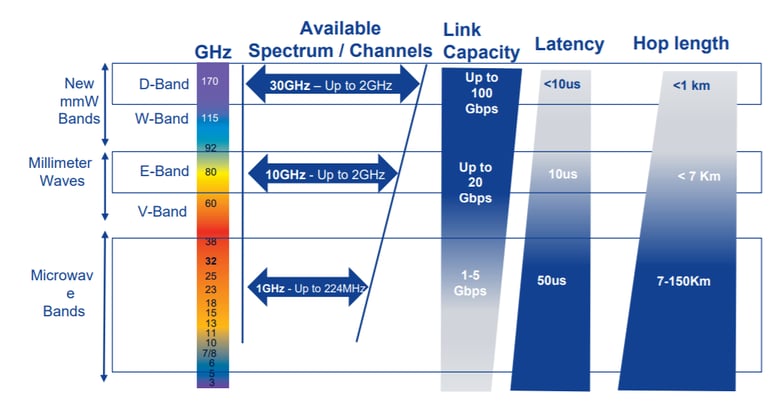|
|
In my previous blog post I posed the hypothesis that in today’s digitalization age connectivity should be viewed as a critical resource. Many of the economic and social problems countries face are related to the digital divide and need to connect the unconnected. A key remedy to cure these macroeconomic problems is widechannel bandwidth. Today I want to discuss what is technologically possible and feasible, and to establish which channel size should and could practically be used for wireless transmission. To help regulators, institutes such as the CEPT, ETSI and ITU have made it their mission to provide valuable technological guidance, which we will look at below.
What we CAN do and what we SHOULD do
Bandwidth is limited, no matter whether we’re transmitting in millimeter wave or microwave frequencies. The two main limitations to bandwidth are related to technology and regulation. Policymakers and regulators need to strike a fine balance between what is possible and what is feasible. And that’s quite a headache. On the one hand, they must enable businesses, government organizations and private people to enjoy the maximum transmission of capacity that is technologically possible. The wider the channel, the more capacity can be delivered. On the other hand, they need to make sure that there are no unwanted side effects, such as interferences within or across different spectrum bands, caused by allowing too wide a bandwidth.
As we have already established, connectivity is a resource. And like with any other resource, regulators quite rightly request that we maximize the use of the capacity that is currently available, before shouting out for wider channels. One way to maximize spectral efficiency for point-to-point wireless connectivity is to use both vertical and horizontal polarization by means of XPIC technology. Other technologies used to increase spectral efficiency are 4x4 LoS MIMO and Advanced Frequency Reuse and aggregation of multiple carriers from different bands into a single connection (i.e. multiband). Advanced microwave technology enables all these features for a large range of spectrum and bandwidth channels. So, we can tick that box.
In their report on microwave and millimeter wave for 5G transport, ETSI makes a strong argument for the need for wider channel bandwidth. They describe wider channel bandwidth as one of the fundamentals for allowing the higher capacity needed to fulfill all 5G requirements. But why not simply use more of the narrower channels? Why do regulators need to go through the trouble of allowing wider channels when it is possible to simply use two adjacent channels to provide the same amount of capacity?
Under current regulations, two narrow channels assume the use of two modems and two RF transmission flows. This means double the amount of hardware needed and, depending on national regulations, an increase in spectrum costs. If we scale this up to the number of required links, we quickly see that this proves to be a real barrier to entry for capacity providers in urban and rural areas. Moreover, there are negative secondary effects on economic growth and social welfare, as discussed previously.
What the experts say
So, let’s look at what technical experts have to say about using one channel with double the size compared to using two narrower ones. In its report on wide channels (updated 01/2020), the ECC (of CEPT) showed that there is no need to worry about interference issues when using a wider channel vis-à-vis two narrow channels. Testing for worst-case scenarios, the ECC concluded that not only do wider channels not pose a threat for in-band interreference, but also no major problem is expected regarding adjacent narrower bands, as feared. In that same report the ECC refers to spectral efficiency, stating that using one channel of double the size allows the transmission of more capacity than if two half-sized channels were used. The reason for that is that there is some interreference when two narrower channels are used simultaneously. This interference is erased when using one wider channel. So, in this case 1+1 is, in fact, more than 2. Widechannel bandwidth increases spectral efficiency.
The ECC recommendation for maximum channel bandwidth is listed in the table below:
.png?width=780&height=290&name=MicrosoftTeams-image%20(2).png)
Source: Evolution of Fixed Services for wireless backhaul of IMT 2020 / 5G, ITU-R Workshop Geneva, 2019.04.29
The need for wide channel bandwidth can be heard around the world and not just Europe. In its workshop on the evolution of Fixed services for wireless backhaul of IMT 2020/5G in Geneva last year, the ITU also recommended wider bands of 112MHz and 224MHz for microwave bands. The aim is to provide 1-5 Gbps over a hop length of anything between 7km and 150km. Widechannel bandwidth is viewed by ITU as critical to address forthcoming 5G use cases (see diagram below).

Source: Evolution of Fixed Services for wireless backhaul of IMT 2020 / 5G, ITU-R Workshop Geneva, 2019.04.29
In summation, everyone needs more capacity, which delivers economic, social and personal benefits. One of the most significant – and easiest – ways to provide more connectivity in a secure, speedy and cost-effective manner is by widening the channels through which the bits and bites travel. Listening to technology experts, who have thoroughly tested all scenarios to make sure there are no adverse consequences, we understand that widechannel bandwidth is just what the doctor ordered.
To learn about advanced wireless hauling solutions


